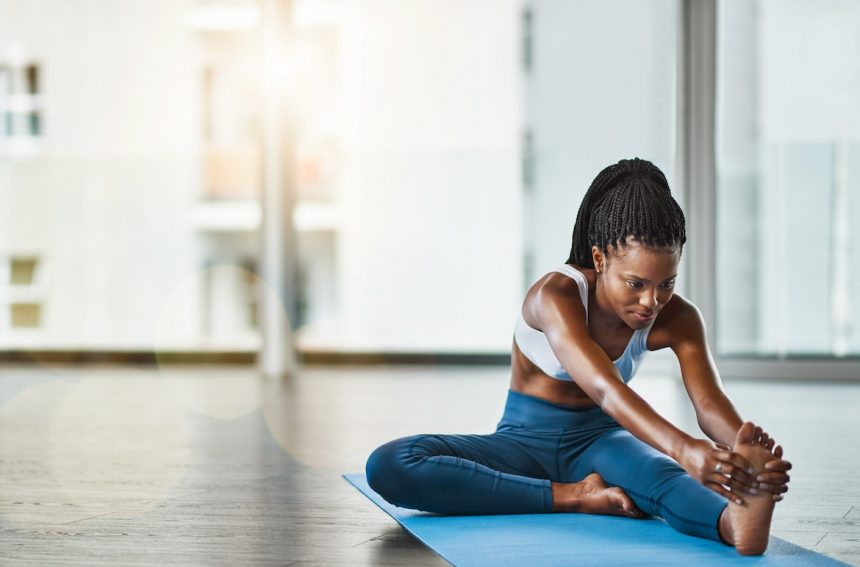If you’ve been waking up feeling stiff and achy, or if you have noticed that your posture is not as good as it should be, it’s time to start stretching. A good stretching program has more benefits than just being able to impress your friends by touching your toes. You’ll be surprised at how much better your body moves and feels when your overall mobility improves.
“An effective stretching program is your ‘joint maintenance’ and is the way to prevent pain and injury,” says Grayson Wickham, DPT, CSCS, physical therapist, certified strength and conditioning specialist, and founder of Movement Vault. “It also ensures that your body and joints are moving like they should.”
If you’re not sure where to start in your journey to better flexibility, we’ve got you covered. Ahead, we dive into how to become more flexible with expert tips, exercises, and a program you can follow.
### What is flexibility and why is it important?
When you think of stretching, you may think of holding a position for a period of time—like holding a hamstring stretch, for example. While that’s part of it, there are many ways you can improve your flexibility and mobility. The trick is knowing how to stretch, when to stretch, and how to incorporate more moves that encourage mobility throughout your day.
“People spend way too much time sitting and not moving, and are not getting in enough varied movement in their daily routine,” Wickham says. “An effective active stretching program is the antidote for the tight muscles, poor muscle activation, and poor mobility that is the consequence of all of this lack of movement and sitting.”
In fact, a 2017 study in BMC Health Services Research saw a correlation between better mobility as you age and a longer lifespan. While correlation doesn’t equal causation, it’s definitely an incentive to start stretching!
### Flexibility vs. mobility: What’s the difference?
Many people use the terms flexibility and mobility interchangeably–but they actually have very different meanings. “Flexibility is a precursor to mobility. In order to have good mobility, you must first have good flexibility,” Wickham says.
“Having good flexibility by itself is not very useful unless you’re trying to show off on social media by doing the splits or other passive, non-moving positions.” Flexibility, on the other hand, is the amount you can passively elongate or stretch out a connective tissue without contracting muscles and without actively moving a joint, according to Wickham.
“You can think about mobility as the amount of range of motion that you actively move your joint through,” he explains. For example, being able to do the splits means you’re flexible. If you can actively kick your leg up high (think of the Rockettes doing their eye-high leg kicks), then you have good mobility.
“Mobility is what you should focus on. Active joint mobility is what translates to active movement in your day-to-day activities, in the gym, and in your sport,” he says. It also helps you do daily activities—like bending down, reaching overhead, or getting out of bed—easier. Ideally, you should have both good flexibility and full range of motion in your joints, along with good mobility to help you move with ease. A stretching routine will help you get both.
### The benefits of stretching that’ll motivate you to start a routine
A regular stretching routine has many benefits on both your physical and mental wellbeing. Here are five reasons to start stretching.
1. **It prevents injuries**: “Injury prevention is probably the number one reason for flexibility,” says Denise Chakoian, CPT, founder of CORE Studios in Providence, Rhode Island. “It helps to keep the muscles more limber, and you also recover quicker from workouts.” Stretching helps prevent muscle imbalances and allows the joint to move through its full range of motion. This ensures that your body is moving like it should and is less prone to injuries.
2. **It improves athletic performance**: A 2017 review in Sports Medicine found that doing dynamic stretching before exercise or athletic performance increases muscle power, force, sprint speed, and jump height. It improves muscle strength as your muscles and joints are moving and working like they should. Wickham says stretching also improves body awareness and balance, which also translates into improved performance with sports and daily activities.
3. **It enhances range of motion**: Stretching helps maintain and improve the range of motion in your joints, according to a 2012 research article in the International Journal of Sports Physical Therapy. All types of stretching are beneficial, per the article, including static and dynamic, but proprioceptive neuromuscular facilitation (PNF) stretching produces the most immediate gains. (More on PNF stretching below!)
4. **It boosts cardiovascular health**: You may be surprised to learn that stretching is good for your heart. A 2020 study in the Journal of Physiology found that a 12-week stretching routine lowered blood pressure, improved blood flow, and decreased arterial stiffness. This translates into a decreased risk of strokes and heart attacks.
5. **It promotes relaxation**: Feeling stressed? A regular stretching routine helps to loosen up tight muscles, increases circulation, and leaves you feeling relaxed and less tense.
An effective stretching program is your ‘joint maintenance’ and is the way to prevent pain and injury. It also ensures that your body and joints are moving like they should. —Grayson Wickham, DPT, CSCS
### Tips on how to become more flexible and mobile
To improve your mobility and flexibility, it’s important to know when and how to stretch. There are different types of stretching techniques.
1. **Static stretching**: This what most people think of when they think about stretching. This is when you do a stretch and hold it in place for 30 to 60 seconds. Experts say this type of stretching improves flexibility and range of motion, but should be done after exercise when your muscles are warmed up. Doing static stretches before an activity may decrease strength and performance, according to a 2019 review in Frontiers in Physiology. However, this side effect is probably felt only in elite or competitive athletes.
2. **Dynamic stretching**: This is when you actively move your body through a stretch. This type of stretching should be done as a warm-up before an activity, and it helps improve range of motion and mobility. Examples of dynamic stretches include leg swings, arms circles, and lunges.
3. **PNF stretching**: This is a more active type of stretching that improves mobility, strength, and joint stability. It also happens to be Wickham’s preferred method of stretching. “Active stretching happens when you maximally stretch out a muscle and then contract that same muscle while it’s maximally stretched out. You will hold this muscle contraction for a specific amount of time,” Wickham says. “You should focus on active stretching, which will significantly improve your flexibility and active mobility at the same time. This is one reason why active stretching is a great use of time and the best bang for your buck.”
Here are more tips on stretching effectively:
– For best results, do dynamic stretches as a warm-up before the activity, followed by active, PNF, or static stretches after the activity. Not a fan of stretching before or after exercise? Try a 15-minute flexibility flow. “I like to do a flow for flexibility,” Chakoian says. “I find that stretching cold is not a great idea, but to move our bodies in a flow with one move after another helps improve mobility.” Yoga is also a great exercise to combine mobility and strengthening.
– Look for moments throughout the day to stretch and move more. If you sit at a desk all day, stand up at least once an hour and do some arm circles, hip flexor stretches, and chest opening stretches to prevent a hunched position. If you stand all day, do some gentle trunk rotations on the floor. “Start by doing small movements on the floor, with some deep breathing exercises,” Chakoian says.
– Utilize tools to help you stretch effectively, like a foam roller or yoga block. “Using a tool like a long resistance band is very helpful to improve your flexibility daily,” Chaloian says. The band can be placed over your foot when doing a hamstring stretch or between your hands to help you stretch out your shoulders.
### The best moves to improve mobility
Wickham shares his seven favorite active or PNF stretches to try at home…






